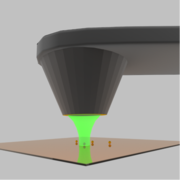A cantilever-based sub-λ3 mode-volume optical microcavity

Microcavities have been popular for a number of applications, ranging from micorlasers, cavity quantum electrodynamics studies and sensing. The enhanced coupling in the cavity is usually achieved via a high quality factor. This, however, severely limits the operating bandwidth of the cavity. Using small radius of curvature micromirrors, we have succeeded in creating a very small microcavity that accommodates high Purcell factors while maintaining a THz operating bandwidth.
Using focused ion beam milling, we fabricate a concave micromirror of radius of curvature 2.6 micrometers on the tip of an atomic force microscope cantilever. The micromirror approaches a planar dielectric mirror to form a plane-concave microcavity with a mode volume of only 0.8 λ3. The sensitivity of this microcavity to small perturbations is demonstrated by detecting the modification of the cavity resonance by a 80 nm gold particle. This type of a microcavity has the capability to strongly modify radiation emitted by a single molecule in a crystal, effectively turning it into a two level system, but it can also be used to detect biomolecules like viruses.
H. Kelkar, D. Wang, D. Martin-Cano, B. Hoffmann, S. Christiansen, S. Götzinger, V. Sandoghdar, Phys. Rev. Applied 4, 0504010 (2015)






